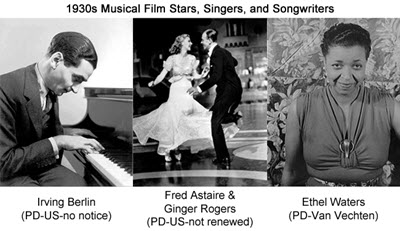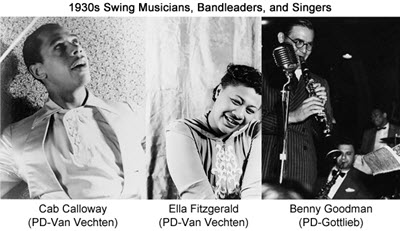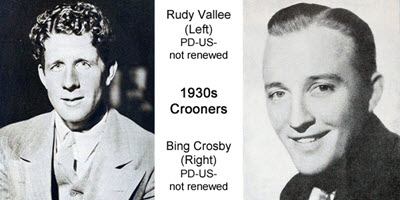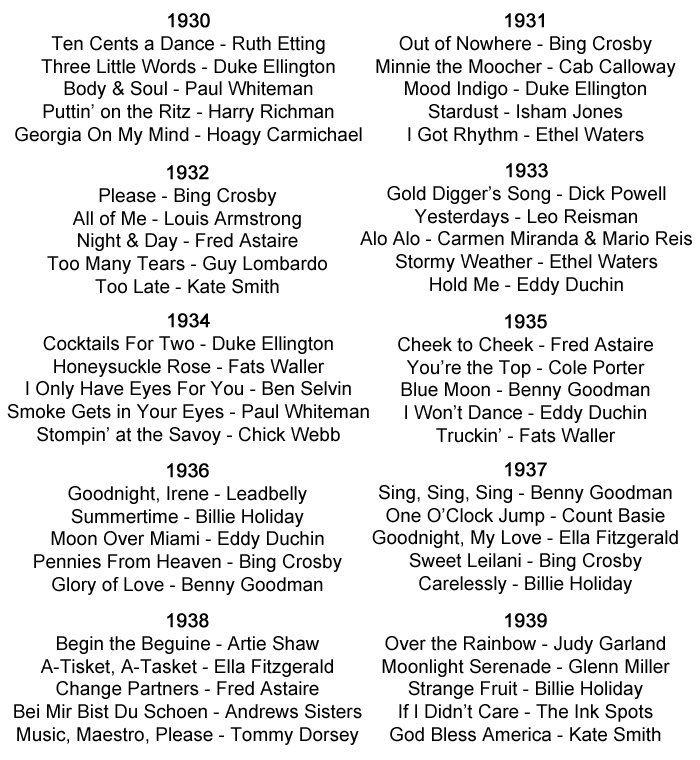Fashion in the 1930's and 40's Music of the 1930's and 40's
Music Styles, Bands and Artists During the 1930's
The 1930s were shaped by the contrasting moods of the Cracking Depression and the glamorous beginnings of Old Hollywood. Pop music was every bit impacted by these forces and as domicile radios became more than common, the music industry began to keep track of and measure the popularity of canvas music and records through sales. The radio program "Your Striking Parade" debuted in 1935 which showcased the most popular songs of the week. Billboard magazine too began publishing their "Striking Parade" on January 4, 1936 as a list of the most popular songs of the time.
Jazz music evolved into different styles with Swing and Large Band becoming prominent throughout the 1930s and the 1940s. Musical films influenced pop culture and many film stars were as well popular singers of the time. Broadway creators moved to Hollywood and adapted their phase shows for a wider audience on the silver screen. Crooners and multi-media solo entertainers grabbed the attention of a younger audience and artists like Rudy Vallee were crowned every bit some of the first heart throbs, hosting their own shows on radio and making appearances in films all while churning out recorded hits of their ain.
Styles of Music Popular in the Thirties
Popular Musical Singers and Songwriters
Cole Porter, Irving Berlin, Jerome Kern, George Gershwin, Ira Gershwin, Richard Rodgers, Lorenz Hart, Oscar Hammerstein 2, Fred Astaire, Ginger Rogers, Ethel Merman, Ethel Waters, Eddie Cantor, Shirley Temple, Dick Powell, Betty Grable, Joan Blondell, Irene Dunne, Johnny Mercer, Allen Jones, Mae West
Popular Swing Musicians
Cab Calloway, Benny Goodman, Chick Webb, Knuckles Ellington, Artie Shaw, Louis Armstrong, Glenn Miller, Ella Fitzgerald, Woody Herman, Fletcher Henderson, Billie Holiday, Count Basie, Jimmy Dorsey, Tommy Dorsey
Pop Crooners
Bing Crosby, Rudy Vallee, Fred Astaire, Perry Como, Russ Columbo, Johnny Mercer, Nat King Cole, Frank Sinatra, Hoagy Carmichael, Eddie Cantor, Louis Jordan, Louis Prima, Mildred Bailey, Annette Hanshaw, Ethel Shutta
Picture show Musicals
Musical films were an important function of popular music during the 1930s, offering a brief reprieve from the grim reality of the Great Depression and were an easy and affordable means of entertainment. These films opened a door to the glamorous world of Hollywood, showcasing song and dance numbers in front of a stylish background. There was a major boom in the production of musicals every bit the engineering science of adding synchronized audio improved dramatically following the release of the first talking picture, "The Jazz Singer," in 1927. Some of the most popular musical movies that were released during the 1930s include Bright Lights (1930), 42nd Street (1933), The Gay Divorcee (1934), Top Hat (1935), Showboat (1936), Alexander'due south Ragtime Band (1938), The Wizard of Oz (1939), and Babes In Artillery (1939). Entertainers that appeared in these films were often well-rounded and had Vaudevillian or Broadway backgrounds to draw from.
The early years of musical films attracted some of Broadway's biggest talents to Hollywood and several songwriters signed contracts with major film studios during the 1930s. Some of the creators that were drawn to Hollywood included Richard Rodgers, Lorenz Hart, Cole Porter, Oscar Hammerstein 2, Irving Berlin, George and Ira Gershwin, and Jerome Kern. The implementation of the Production Code in 1934, establishing stricter standards for the content of films, seemed to stifle inventiveness in the concern and could have been a factor in many of these creators deciding to return their focus to Broadway afterward in the decade. The musicals in the Thirties were too known for their elaborately choreographed trip the light fantastic numbers and some of the near iconic choreography came from Busby Berkeley. His films featured intricate and geometric placement of dancers and showgirls in what was chosen a kaleidoscopic shot, sometimes shown from an over-head angle.
Some of the biggest names in music either emerged from or dabbled in picture musicals during the decade, many forging careers that would last several decades. Popular artists associated with the movie musical included Bing Crosby, Judy Garland, Ruth Etting, Eddie Cantor, Ethel Waters, Ethel Merman, Cab Calloway, Johnny Mercer, Shirley Temple, Mae Westward, Betty Grable, Joan Blondell, Irene Dunne, Carole Landis, and Dick Powell. The most popular and emblematic of the decade were Fred Astaire and Ginger Rogers who sang and danced together on screen equally as ii of the most famous stars in Hollywood. Fred Astaire and Ginger Rogers epitomized the multi-talented entertainers that took the decade past storm and they starred in 10 musical comedy films together (all were released in the 1930s except one). Some of their popular films were "Tiptop Chapeau," "The Gay Divorcee," and "Swing Time."

The Swing Era
An offshoot of the previously pop Jazz genre, Swing music (paw in manus with Big Band music) was developed near the terminate of the 1920s and it reached the height of its popularity from the mid-1930s to the early 1940s. Benny Goodman was often cited as introducing the style to the masses with his performances at the Palomar Ballroom start in 1935. Swing differed from traditional jazz in that the songs would often accept a stronger driving force. They focused on the rhythm sections and allowed some improvisation while often featuring a soloist or singer prominently. The way was as well adaptable with other genres as fusions with state and dejection were too popular. Bandleaders like Chick Webb, Fletcher Henderson, Cab Calloway, Gene Krupa, Artie Shaw, and the Dorsey Brothers among many others were also of import in the early establishment of swing and the popularization of the genre. Many bands created unlike arrangements of the aforementioned songs, leading to slightly dissimilar versions vying for popularity on the charts. Some of the most iconic 1930s songs of the swing era included "Begin the Beguine," "Minnie the Moocher," "It Don't Mean a Thing (If Information technology Own't Got That Swing)," and "Sing, Sing, Sing (With a Swing)."
As with traditional jazz and many other popular music genres throughout the 20th Century, in that location was a racial component to swing with very petty integration betwixt black and white ring leaders, band members, and vocalists. Many black bands were treated differently and denied credit and recognition for their contributions to the genre. Segregation and discrimination in the United States prevented many blackness swing bands from reaching the pinnacles of their careers but some band leaders similar Cab Calloway and Count Basie and singers similar Ella Fitzgerald and Billie Holiday attained mainstream success. Billie Holiday was notably hired equally the first black female vocalist to tour the South with a white swing band when she joined Artie Shaw & His Orchestra in 1938.

Crooners and the First Pop Stars
While idea of every bit a derogatory term for singers of sentimental pop and jazz standards, many "Crooners," as they were chosen, became pop during the Thirties. The genre fit well with the style of radio at that moment and created some of the first music center throbs, popular stars, and teen idols of the fourth dimension. Artists similar Bing Crosby, Russ Columbo, Hoagy Carmichael, and Rudy Vallee best represented the more often than not male-dominated genre. Vallee was a ubiquitous voice of the decade, appearing in films and hosting his own radio plan besides as recording hit songs like 1932's "Say It Isn't So" and "Blood brother Can Yous Spare a Dime?" (besides recorded by Bing Crosby), and 1934'south "P.South. I Love You."
Bing Crosby, while not necessarily a teen idol type, was also considered a crooner and became i of the first multi-media stars. He was i of the all-time selling musicians of all fourth dimension and certainly dominated the charts of the 1930s. Crosby got his first by recording with popular orchestras and before long found solo success with a weekly radio show. He belted out his hits on the air and they would quickly accomplish the summit of the charts as listeners flocked to his distinctive bass-baritone vocalization. He began starring in several brusk films where he appeared as himself which helped launched his career. He remained popular throughout the 1940s and Fifties, getting larger roles on screen and still making waves as a hit-making recording artist and performer.

Peak Hits From Each Year in the 1930s

Pop Songs from the 1930's
1930 - 10 Cents a Dance - Ruth Etting (-) Three Fiddling Words - Duke Ellington (-) Body & Soul - Paul Whiteman (-) Puttin' on the Ritz - Harry Richman (-) Georgia On My Mind - Hoagy Carmichael,
1931 - Out of Nowhere - Bing Crosby (-) Minnie the Moocher - Cab Calloway (-) Mood Indigo - Duke Ellington (-) Stardust - Isham Jones (-) I Got Rhythm - Ethel Waters,
1932 - Please - Bing Crosby (-) All of Me - Louis Armstrong (-) Night & Mean solar day - Fred Astaire (-) Too Many Tears - Guy Lombardo (-) Besides Tardily - Kate Smith,
1933 - Gold Digger's Song - Dick Powell (-) Yesterdays - Leo Reisman (-) Alo Alo - Carmen Miranda & Mario Reis (-) Stormy Weather - Ethel Waters (-) Agree Me - Eddy Duchin,
1934 - Cocktails For Two - Duke Ellington (-) Honeysuckle Rose - Fats Waller (-) I Only Have Eyes For You - Ben Selvin (-) Smoke Gets in Your Eyes - Paul Whiteman (-) Stompin' at the Savoy - Chick Webb,
1935 - Cheek to Cheek - Fred Astaire (-) You lot're the Top - Cole Porter (-) Blue Moon - Benny Goodman (-) I Won't Dance - Eddy Duchin (-) Truckin' - Fats Waller,
1936 - Goodnight, Irene - Leadbelly (-) Summertime - Billie Holiday (-) Moon Over Miami - Eddy Duchin (-) Pennies From Heaven - Bing Crosby (-) Glory of Dear - Benny Goodman,
1937 - Sing, Sing, Sing - Benny Goodman (-) One O'Clock Bound - Count Basie (-) Goodnight, My Love - Ella Fitzgerald (-) Sweet Leilani - Bing Crosby (-) Carelessly - Billie Holiday,
1938 - Brainstorm the Beguine - Artie Shaw (-) A-Tisket, A-Tasket - Ella Fitzgerald (-) Change Partners - Fred Astaire (-) Bei Mir Bist Du Schoen - Andrews Sisters (-) Music, Maestro, Delight - Tommy Dorsey,
1939 - Over the Rainbow - Judy Garland (-) Moonlight Serenade - Glenn Miller (-) Strange Fruit - Billie Holiday (-) If I Didn't Care - The Ink Spots (-) God Bless America - Kate Smith
0 Response to "Fashion in the 1930's and 40's Music of the 1930's and 40's"
Post a Comment